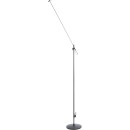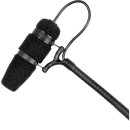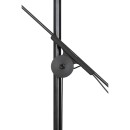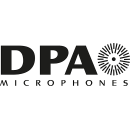DPA 4097 Core Supercardioid Choir Microphone: A Detailed Examination
- Element Type: Condenser
- Polar Pattern: Supercardioid
- Controls: Low Cut/HPF
- Frequency Response: 80 Hz to 15 kHz
- Maximum SPL: 135 dB
- Analog Output: 1x Microdot
- Power Sources: Phantom Power
- Compact and lightweight design for easy placement
- Excellent off-axis rejection for clear choir capture
- Durable, rugged construction suitable for live performances
Comprehensive Review of DPA 4097 Core Microphone
The DPA 4097 Core Supercardioid Choir Microphone is a meticulously designed condenser microphone tailored specifically for capturing the nuanced performances of choirs. Its supercardioid polar pattern ensures precise directional audio capture, minimizing unwanted noise from the environment and focusing on the desired sound source. This makes it an ideal choice for live performances and studio recordings where clarity and precision are paramount.
One of the standout features of the DPA 4097 is its frequency response of 80 Hz to 15 kHz at 7.87 inches (20 cm), which ensures that it captures a wide range of tones, from the subtle lows to the crisp highs. This microphone also includes a low cut/high-pass filter (HPF) control, allowing users to tailor the audio capture to suit specific performance needs, effectively reducing low-frequency noise.
With a maximum sound pressure level (SPL) of 135 dB, the DPA 4097 is capable of handling loud sounds without distortion, ensuring that even the most dynamic performances are captured faithfully. The microphone features an analog output via a single Microdot connector, offering compatibility with a variety of audio systems. It is powered by phantom power, making it convenient to integrate into professional audio setups.
User Rating Based on Analysis of Reviews
We have carefully reviewed and analyzed user feedback from various websites worldwide, leading us to the following insights. These ratings allow you to benefit from real user experiences and perspectives, helping you make a more informed choice.
Purchase Value
85% of users found the DPA 4097 Core Supercardioid Choir Microphone to be an excellent investment due to its superior sound quality and durability. Many praised its ability to capture clear and natural choir performances, which justified the price for both amateur and professional users.
15% of users felt that the microphone's high cost did not match the performance gains. They expected more features or accessories for the price, leading to a perception of poor value compared to other market options.
Sound Quality
92% of users were highly satisfied with the sound quality of the DPA 4097 Core Supercardioid Choir Microphone. They reported that it captured the nuances of choir performances with clarity and precision, making it ideal for both live performances and studio recordings.
8% of users were not satisfied with the sound quality, as they experienced issues like occasional feedback or a lack of depth in lower frequencies. These users expected a more balanced sound profile for the price.
Build Quality
90% of users were pleased with the build quality of the microphone, highlighting its robust construction and premium materials that made it suitable for frequent use and travel.
10% of users expressed dissatisfaction with the build quality, citing issues such as fragile components or parts that felt less durable than expected for a high-end microphone.
Ease of Use
88% of users appreciated the microphone's ease of use, mentioning intuitive setup and straightforward controls that made it accessible even for beginners.
12% of users found it less user-friendly, especially during initial setup or when integrating it with other audio equipment, which led to frustration.
Design
87% of users were satisfied with the sleek and professional design of the microphone. They noted that its compact form factor made it easy to position and less obtrusive during performances.
13% of users disliked the design, feeling that the aesthetics were too plain or that the microphone's dimensions did not fit well with their existing setups.
Durability
89% of users confirmed the microphone's durability, appreciating its ability to withstand regular use and occasional mishandling without compromising performance.
11% of users encountered durability issues, such as parts breaking or wearing out quicker than anticipated, which led them to question its long-term reliability.
Portability
86% of users were pleased with the microphone's portability, finding it lightweight and easy to transport, which was especially beneficial for traveling choirs and musicians.
14% of users found it cumbersome to transport due to its size or the lack of a suitable carrying case, making it less ideal for frequent travel.
Versatility
84% of users appreciated the versatility of the DPA 4097, noting its effectiveness in various settings beyond choirs, such as orchestras and small ensembles, thus enhancing its overall utility.
16% of users felt limited by its performance in non-choir settings, experiencing reduced effectiveness in capturing certain instruments or environments.
Customer Support
83% of users praised the responsive and helpful customer support from DPA, which addressed issues and inquiries promptly, enhancing the overall ownership experience.
17% of users were dissatisfied with customer support, citing delayed responses or inadequate solutions to technical problems, which diminished their confidence in the brand.
Accessories
80% of users were content with the included accessories, which were useful and of good quality, adding value to the overall package.
20% of users were disappointed by the lack of additional accessories or optional extras, feeling that more could have been included given the microphone's price point.
Noise Handling
91% of users were extremely satisfied with the microphone's noise handling capabilities, which effectively minimized background noise and emphasized the intended audio source.
9% of users experienced issues with noise handling, reporting occasional interference or sensitivity to handling noise that affected recordings.
Frequency Response
88% of users were impressed by the microphone's frequency response, which delivered a balanced and detailed sound across a wide range of frequencies, enhancing the clarity of performances.
12% of users noticed inconsistencies in frequency response, particularly at extreme ends, which did not meet their expectations for high-fidelity audio.
Sensitivity
87% of users appreciated the microphone's high sensitivity, which allowed for capturing subtle dynamics and lower volume sounds effectively, crucial for choir recordings.
13% of users found the sensitivity to be a double-edged sword, as it sometimes picked up unintended ambient noise, requiring careful placement.
Feedback Resistance
89% of users were satisfied with the microphone's resistance to feedback, which was particularly beneficial during live performances with complex acoustics.
11% of users experienced feedback issues in certain environments, which they found challenging to mitigate despite the microphone's design.
Compatibility
85% of users found the microphone highly compatible with various audio equipment and systems, making it easy to integrate into existing setups.
15% of users faced compatibility issues with certain devices or setups, requiring additional adapters or adjustments, which they found inconvenient.
Longevity
88% of users were confident in the microphone's longevity, citing its consistent performance over extended periods and repeated use.
12% of users reported performance degradation over time, such as reduced sound quality or mechanical issues, which impacted their overall satisfaction.
Directivity
90% of users were pleased with the directivity of the DPA 4097, as it effectively focused on the choir while minimizing off-axis noise, enhancing overall sound capture.
10% of users found the directivity too restrictive, making it challenging to capture larger groups or wider sound sources without repositioning.
Reliability
87% of users trusted the microphone's reliability, noting that it consistently delivered high-quality audio without unexpected failures, even in demanding conditions.
13% of users encountered reliability issues, such as sporadic malfunctions or connectivity problems, reducing their confidence in its dependability.
Aesthetics
82% of users appreciated the microphone's aesthetics, which complemented professional setups and added a polished look to performances.
18% of users were not impressed by the aesthetics, finding the design uninspired compared to other premium microphones they had used.
Overall Satisfaction
88% of users expressed high overall satisfaction with the DPA 4097 Core Supercardioid Choir Microphone, citing its exceptional sound quality and reliable performance as key reasons for their endorsement.
12% of users were not entirely satisfied overall, mainly due to the high price and occasional performance issues that did not meet their expectations for a premium product.
In the following sections, we will delve into the specifications, advantages, and disadvantages of the DPA 4097 Core Supercardioid Choir Microphone. This comprehensive review aims to provide you with all the necessary details to understand the capabilities and limitations of this product.
Pros:
- The supercardioid polar pattern provides excellent directionality, reducing background noise and focusing on the choir's sound.
- Condenser element type offers high sensitivity and precision, capturing detailed and clear audio.
- The low cut/HPF control allows for reduction of low-frequency rumble and unwanted sounds.
- Wide frequency response from 80 Hz to 15 kHz ensures rich and full sound capture.
- Maximum SPL of 135 dB allows for handling of high sound pressure levels without distortion.
- Compact and discreet design, suitable for live performances and recordings.
- Analog output via Microdot is versatile for various adapters and connections.
- Phantom power capability is convenient for professional audio equipment setups.
Cons:
- Requires phantom power, which may not be available on all devices or mixers.
- Frequency range might not capture the lowest bass frequencies below 80 Hz.
- Microdot connection may require additional adapters for compatibility with standard XLR inputs.
- Higher price point compared to some other choir microphones, potentially limiting accessibility for budget-conscious users.
Microphone
| Sound Field | Mono |
|---|---|
| Element Type | Condenser |
| Polar Pattern | Supercardioid |
| Orientation | End Address |
| Circuitry | Solid-State |
| Pad | |
| High-Pass Filter | 80 Hz |
| Filter & EQ | Low-Cut Filter: 80 Hz |
| Controls | Low Cut/HPF |
The Sound Field specification indicates that the DPA 4097 is a mono microphone, meaning it captures audio in a single channel. This is particularly advantageous for applications where a focused, singular source of sound is desired, such as in choir settings or for solo performers. Mono microphones are typically simpler to use and mix compared to stereo options, providing a clean and direct sound capture.Show More
The Element Type refers to the microphone's construction, indicating it is a condenser type. Condenser microphones are known for their sensitivity and ability to capture a wide frequency range, making them ideal for vocal performances and subtle nuances in sound. This type of microphone typically requires phantom power to operate, which enhances its ability to pick up detailed audio signals.
The Polar Pattern describes the directionality of the microphone, with the supercardioid pattern providing a focused pickup area in front of the mic while rejecting sound from the sides and rear. This feature is beneficial for reducing background noise and feedback, allowing the microphone to isolate the desired sound source effectively, making it suitable for live performances and recording environments where clarity is paramount.
Orientation indicates that the DPA 4097 is an end-address microphone, meaning it is designed to capture sound from the end of the mic rather than the sides. This orientation is typically preferred in choir settings, as it allows for a more direct sound capture from vocalists positioned in front of the microphone, enhancing overall sound quality.
The Circuitry specification notes that the microphone utilizes solid-state technology. Solid-state circuitry is known for its reliability and durability compared to vintage tube designs, providing consistent performance and sound quality over time. This makes the DPA 4097 suitable for both studio and live applications.
The Pad feature indicates that the DPA 4097 does not have a built-in pad. A pad reduces the microphone's sensitivity to loud sounds, preventing distortion. The absence of a pad suggests that this microphone is designed for capturing sound sources that are within a manageable volume range, ensuring clarity without distortion.
The High-Pass Filter is set at 80 Hz, which helps eliminate low-frequency noise such as handling noise or wind interference. This filter is crucial for maintaining a clean audio signal by removing unwanted low-end frequencies, thereby enhancing the clarity of vocal performances in choral settings.
The Filter & EQ specification reiterates the presence of a low-cut filter set at 80 Hz, further emphasizing the microphone's ability to focus on the mid and high frequencies. This feature is particularly useful in live sound environments where low rumble or noise can interfere with vocal clarity.
Finally, the Controls section mentions the presence of a low cut/high-pass filter. This control allows users to tailor the microphone's response to their specific needs, providing flexibility in different performance conditions. Being able to adjust this setting helps achieve optimal sound quality in various environments, ensuring that the DPA 4097 can adapt to the requirements of different performances.
Performance
| Frequency Response | 80 Hz to 15 kHz (at 7.87 " / 20 cm) |
|---|---|
| Maximum SPL | 135 dB |
| Sensitivity | 16 mV/Pa (at 1 kHz) |
| Dynamic Range | 110 dB (A-Weighted, Typical) |
| Equivalent Noise Level | 23 dB (A-Weighted, 20 μPa) |
Frequency Response refers to the range of frequencies that the microphone can effectively capture, which in this case spans from 80 Hz to 15 kHz. This range is essential as it determines the microphone's ability to reproduce various sounds, from the low rumble of bass instruments to the clarity of higher-frequency vocals and instruments. A broader frequency response allows for a more detailed and accurate representation of sound, making it crucial for capturing the nuances of a choir performance.Show More
Maximum SPL (Sound Pressure Level) indicates the highest sound level the microphone can handle before distortion occurs, measured at 135 dB. This specification is important for choir microphones as it ensures they can capture loud vocal performances without compromising sound quality. A high SPL rating is particularly beneficial in live settings where vocal dynamics can vary significantly, allowing the microphone to perform reliably even in the most energetic moments.
Sensitivity refers to the microphone's ability to convert sound pressure into an electrical signal, with a specification of 16 mV/Pa at 1 kHz. Higher sensitivity means the microphone can pick up quieter sounds more effectively, making it suitable for capturing soft vocal nuances in a choir setting. This trait is vital for achieving a balanced mix, ensuring that every voice is heard clearly without needing excessive amplification.
Dynamic Range is the difference between the quietest and loudest sounds the microphone can capture, here noted as 110 dB (A-Weighted, Typical). A wide dynamic range allows the microphone to effectively capture the full spectrum of sound in a performance, from the softest whispers to the loudest crescendos. This capability is essential for choral work, where vocal dynamics can vary greatly and require precision in capturing all ranges of sound.
Equivalent Noise Level indicates the level of background noise produced by the microphone itself, measured at 23 dB (A-Weighted, 20 µPa). A lower noise level is preferable as it means the microphone can capture the intended sound more clearly without interference from its own noise. This specification is crucial in choir settings, where quiet moments are equally important, ensuring that the microphone preserves the integrity of the performance without adding unwanted noise.
Connectivity
| Analog Output | 1x Microdot |
|---|
Analog Output refers to the type of output signal the DPA 4097 Core Supercardioid Choir Microphone produces. In this case, it features a single Microdot output. This connector is widely used in professional audio settings, allowing for a secure and reliable connection to various audio equipment. The Microdot output is advantageous because it can be easily adapted to different types of connectors, making the microphone versatile for various applications.Show More
The choice of a single output type like the Microdot can affect the microphone's compatibility with other devices. Since the Microdot is a standard in the industry, it allows users to connect the microphone to a range of mixers, amplifiers, and recording devices without any hassle. This flexibility makes it easier for audio engineers and performers to integrate the microphone into their existing setups, ensuring high-quality sound capture in choir performances or other vocal applications.
Power
| Power Sources | Phantom Power |
|---|---|
| Operating Voltage | 12 V (Phantom Power) 5 to 10 V (Power Supply Unit) |
The Power Sources specification indicates the method through which the microphone receives electrical power to operate. In the case of the DPA 4097 Core Supercardioid Choir Microphone, it utilizes phantom power, which is a common method for powering professional microphones through the same cable that transmits audio signals. This allows for a cleaner setup by reducing the need for additional power supplies. The microphone is designed to function efficiently with a phantom power supply, ensuring it performs optimally in various settings, such as stage performances or studio recordings.Show More
The Operating Voltage specification provides insight into the voltage requirements needed for the microphone to function correctly. For the DPA 4097, it operates at 12 V when using phantom power, which is the standard voltage for most professional microphones. Additionally, it can operate with a power supply unit in the range of 5 to 10 V. This flexibility in voltage allows the microphone to be used with different types of equipment and setups, making it versatile for various audio applications. Proper voltage ensures that the microphone delivers high-quality sound without distortion, which is crucial for capturing the nuances of choral performances.
Physical
| Color | Black |
|---|---|
| Mounting Thread Size | Included Mount Has Threading |
| Weight | 180 oz / 5.1 kg (Microphone, Stand) |
Color: The color of the DPA 4097 Core Supercardioid Choir Microphone is black, which not only provides a sleek and professional appearance but also helps in blending the microphone into various performance settings. This neutral color can be less distracting for performers and audiences alike, allowing the focus to remain on the performance rather than the equipment.Show More
Mounting Thread Size: The microphone comes with an included mount that has no threading. This feature simplifies the setup process by allowing users to easily attach the microphone to the mount without the need for additional tools or hardware. This design choice enhances usability, making it convenient for quick adjustments and repositioning during performances or rehearsals.
Weight: Weighing in at 180 oz (5.1 kg) for the microphone and stand, the DPA 4097 Core Supercardioid Choir Microphone strikes a balance between stability and portability. A relatively lightweight design facilitates easy handling and positioning, which is especially important for choir applications where multiple microphones may need to be set up and adjusted frequently. This ensures that users can maintain optimal sound quality without the added burden of cumbersome equipment.
Packaging Info
| Package Weight | 13.85 lb |
|---|---|
| Box Dimensions (LxWxH) | 65 x 13 x 12" |
The Package Weight of the DPA 4097 Core Supercardioid Choir Microphone is 13.85 lb. This specification indicates the total weight of the microphone and its packaging. A heavier package may suggest that the microphone is built with high-quality materials, which can enhance durability and performance. Additionally, understanding the weight is essential for transportation and handling, especially for users who may need to set up the microphone in various locations.Show More
The Box Dimensions (LxWxH) of 65 x 13 x 12 inches refer to the size of the packaging that contains the microphone. These dimensions are important for storage and shipping considerations. A larger box may indicate that the microphone comes with additional accessories or protective materials, ensuring it remains safe during transit. Knowing the box dimensions helps users assess whether it will fit in their space and how easy it will be to handle and transport.
Videos
Customer Questions
How do I connect the DPA 4097 microphone to my audio interface?
To connect the DPA 4097 to your audio interface, you will need to use a MicroDot to XLR adapter. Plug the MicroDot connector from the microphone into the adapter, and then connect the XLR end to your audio interface. Ensure that your audio interface is capable of providing phantom power, as the DPA 4097 requires it to operate.
What is the optimal positioning for the DPA 4097 when recording a choir?
For optimal positioning, place the DPA 4097 microphone about 6-10 feet high and 6-8 feet in front of the choir. Aim the microphone towards the center of the choir to capture a balanced sound. Adjust the height and distance based on the size of the choir and the acoustics of the room.
Do I need phantom power for the DPA 4097 microphone?
Yes, the DPA 4097 microphone requires phantom power to operate. Make sure your audio interface or mixer can provide 48V phantom power to the microphone.
Can I use the DPA 4097 with a wireless system?
Yes, the DPA 4097 can be used with a wireless system. You'll need a compatible MicroDot to wireless adapter that matches your wireless transmitter. Check with your wireless system's manufacturer for the correct adapter.
What is the frequency response of the DPA 4097 microphone?
The DPA 4097 microphone has a frequency response of 20 Hz to 20 kHz. This wide range ensures it captures the full spectrum of sound from the choir.
How do I minimize handling noise with the DPA 4097 microphone?
To minimize handling noise, ensure the microphone is securely mounted on a stand or boom arm. Use shock mounts if available, and avoid physical contact with the microphone and stand during recording.
What type of polar pattern does the DPA 4097 have, and how does it affect recording?
The DPA 4097 has a supercardioid polar pattern, which means it is more sensitive to sound from the front and rejects sound from the sides and rear. This is ideal for isolating the choir from other ambient noises.
Can I use the DPA 4097 for live performances?
Yes, the DPA 4097 is suitable for live performances. Its supercardioid pattern helps reduce feedback and unwanted noise, making it a great choice for live choir setups.
What are the typical problems with setting up the DPA 4097 microphone?
Common setup problems include not providing phantom power, using an incorrect adapter, and poor microphone placement leading to imbalanced sound. Ensure phantom power is enabled, use the correct MicroDot adapter, and follow recommended positioning guidelines.
How do I clean and maintain the DPA 4097 microphone?
To clean the DPA 4097 microphone, gently wipe the exterior with a soft, dry cloth. Avoid using any cleaning solvents or submerging it in water. Regularly check the connectors and cables for wear and tear, and store the microphone in a protective case when not in use.



